
Heinrich Luitpold Himmler was a German politician who was the 4th Reichsführer of the Schutzstaffel, a leading member of the German Nazi Party, and one of the most powerful men in Nazi Germany. He is primarily known for being a principal architect of the Holocaust.

The Reichskommissariat Ostland was established by Nazi Germany in 1941 during World War II. It became the civilian occupation regime in Lithuania, Latvia, Estonia, and the western part of Byelorussian SSR. German planning documents initially referred to an equivalent Reichskommissariat Baltenland. The political organization for this territory – after an initial period of military administration before its establishment – involved a German civilian administration, nominally under the authority of the Reich Ministry for the Occupied Eastern Territories led by Nazi ideologist Alfred Rosenberg, but actually controlled by the Nazi official Hinrich Lohse, its appointed Reichskommissar.

Joachim Peiper was a German Schutzstaffel (SS) officer and war criminal. During the Second World War in Europe, Peiper served as personal adjutant to Heinrich Himmler, leader of the SS, and as a tank commander in the Waffen-SS. German historian Jens Westemeier writes that Peiper personified Nazi ideology, as a purportedly ruthless glory-hound commander who was indifferent to the combat casualties of Battle Group Peiper, and who tolerated, expected, and indeed encouraged war crimes by his Waffen-SS soldiers.
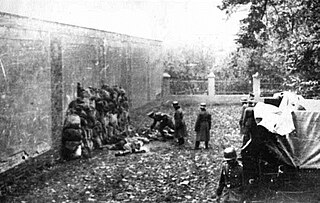
During World War II, the Nazi German Einsatzkommandos were a sub-group of the Einsatzgruppen – up to 3,000 men total – usually composed of 500–1,000 functionaries of the SS and Gestapo, whose mission was to exterminate Jews, Polish intellectuals, Romani, and communists in the captured territories often far behind the advancing German front. Einsatzkommandos, along with Sonderkommandos, were responsible for the systematic murder of Jews during the aftermath of Operation Barbarossa, the invasion of the Soviet Union. After the war, several commanders were tried in the Einsatzgruppen trial, convicted, and executed.
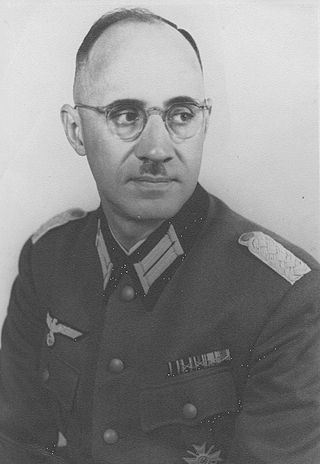
Karl Plagge was a German Army officer who rescued Jews during the Holocaust in Lithuania by issuing work permits to non-essential workers. A partially disabled veteran of World War I, Plagge studied engineering and joined the Nazi Party in 1931 in hopes of helping Germany rebuild from the economic collapse following the war. After being dismissed from the position of lecturer for being unwilling to teach racism and his opposition to Nazi racial policies, he stopped participating in party activities in 1935 and left the party when the war broke out.

The 12th Panzer Division was an armoured division in the German Army, established in 1940.

The siege of Budapest or battle of Budapest was the 50-day-long encirclement by Soviet and Romanian forces of the Hungarian capital of Budapest, near the end of World War II. Part of the broader Budapest Offensive, the siege began when Budapest, defended by Hungarian and German troops, was encircled on 26 December 1944 by the Red Army and the Romanian Army. During the siege, about 38,000 civilians died through starvation, military action, and mass executions of Jews by the far-right Hungarian nationalist Arrow Cross Party. The city unconditionally surrendered on 13 February 1945. It was a strategic victory for the Allies in their push towards Berlin.

During World War II, the German Wehrmacht committed systematic war crimes, including massacres, mass rape, looting, the exploitation of forced labour, the murder of three million Soviet prisoners of war, and participated in the extermination of Jews. While the Nazi Party's own SS forces was the organization most responsible for the Holocaust, the regular armed forces of the Wehrmacht committed many war crimes of their own, particularly on the Eastern Front.
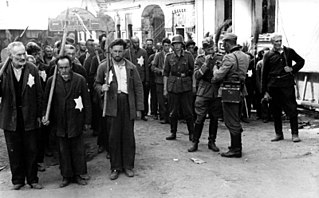
The German invasion of the Soviet Union started on 22 June 1941 and led to a German military occupation of Byelorussia until it was fully liberated in August 1944 as a result of Operation Bagration. The western parts of Byelorussia became part of the Reichskommissariat Ostland in 1941, and in 1943, the German authorities allowed local collaborators to set up a regional government, the Belarusian Central Rada, that lasted until the Soviets reestablished control over the region. Altogether, more than two million people were killed in Belarus during the three years of Nazi occupation, around a quarter of the region's population, or even as high as three million killed or thirty percent of the population, including 500,000 to 550,000 Jews as part of the Holocaust in Belarus. In total, on the territory of modern Belarus, more than 9,200 villages and settlements, and 682,000 buildings were destroyed and burned, with some settlements burned several times.

Maximilian Karl Otto von Herff was a German senior SS commander during the Nazi era. He served as head of the SS Personnel Main Office from 1942 to 1945.

Bialystok District was an administrative unit of Nazi Germany created during the World War II invasion of the Soviet Union. It was to the south-east of East Prussia, in present-day northeastern Poland as well as in smaller sections of adjacent present-day Belarus and Lithuania. It was sometimes also referred to by the designation South East Prussia along with the Regierungsbezirk Zichenau, although in contrast to the latter, it was not incorporated into, but merely attached to East Prussia.

Curt Gustav Friedrich Walther von Gottberg was a high-ranking SS Obergruppenführer who served as Higher SS and Police Leader for central Russia and, from September 1943, as the Generalkommissar (Commissioner-General) of occupied Belarus, combining the highest civil and police powers in that jurisdiction during the Second World War.

The Minsk Ghetto was created soon after the German invasion of the Soviet Union. It was one of the largest in the Byelorussian SSR, and the largest in the German-occupied territory of the Soviet Union. It housed close to 100,000 Jews, most of whom were murdered in The Holocaust.
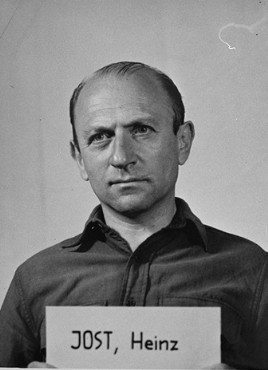
Heinz Jost was a German SS functionary during the Nazi era. He was involved in espionage matters as the Sicherheitsdienst or (SD) section chief of office VI of the Reich Security Main Office. Jost was responsible for genocide in eastern Europe as commander of Einsatzgruppe A from March–September 1942.

The Mińsk Mazowiecki Ghetto or the Mińsk Ghetto was a World War II ghetto set up by Nazi Germany in occupied Poland. Some 7,000 Polish Jews were imprisoned there from all neighbouring settlements for the purpose of persecution and exploitation. Two years later, beginning 21 August 1942 during the most deadly phase of the Holocaust in occupied Poland, they were rounded up – men, women and children – and deported to Treblinka extermination camp aboard Holocaust trains. In the process of Ghetto liquidation, some 1,300 Jews were summarily executed by the SS in the streets of Mińsk Mazowiecki.
Heinz Ludwig Rosenberg, later known as Henry Robertson, was a German-born American author and Holocaust survivor. He survived 11 concentration camps and was one of only approximately fifty German and Austrian Jewish survivors of the "Sonderghetto" in the Minsk ghetto. He later recounted his wartime experiences in the book The Years of Horror: An Authentic Report.
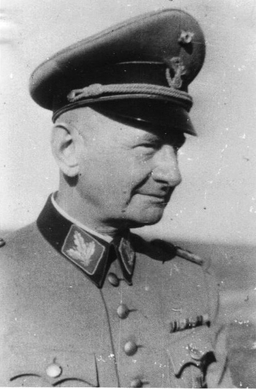
Eberhard Herf was a German police official and war criminal during the Nazi era. He commanded Police Regiment North and Order Police units in Minsk, Belarus. Following the war, Herf was convicted in the Minsk Trial and executed.

The Zambrów massacre was a war crime that took place on the night of 13–14 September 1939. It was one of the major war crimes of the Wehrmacht during the invasion of Poland. During that night, the makeshift prisoner-of-war camp in Zambrów was disturbed by a number of panicked horses, and more than 200 Polish soldiers, trying to move out of their way, were gunned down by German sentries. Some witnesses later said the horses had been purposely released into the camp by the German sentries, who used the incident as a pretext to massacre the prisoners.
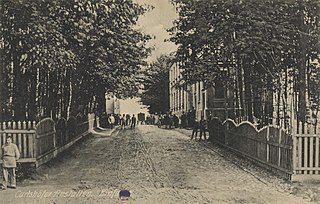
The Carlshof Institutions was a diaconal hospital in Carlshof, East Prussia. Founded in 1882, it was located about 3 km (1.9 mi) east of the town center of Rastenburg (Kętrzyn). Carlshof housed up to 1,500 inmates from all over East Prussia and specialized in treating patients with epilepsy and intellectual disability; it also cared for alcoholics, elderly, and juveniles as well as homeless persons. In World War II, Carlshof served as a military hospital and barracks for Hitler's nearby headquarters at the Wolf's Lair.

Generalbezirk Weißruthenien was one of the four administrative subdivisions of Reichskommissariat Ostland, the 1941–1945 civilian occupation regime established by Nazi Germany for the administration of the three Baltic countries and the western part of the Byelorussian SSR.


















